In recent years, India’s imports from China and the trade deficit with China have risen despite the boycott calls and pandemics. Up to now, around 14% of total Indian imports are from China. This means that opportunities for importers have also increased. For example, importing electric and electronic goods may be of great benefit to you.
However, you may not clearly know about the common problems of the importing process, such as different labels required for the products, certifications, finding reliable Chinese suppliers, etc. All these things probably make you feel that importing from China can be a daunting task.
Take it easy! In this article, we’ll take you through the whole procedure of importing goods from China to India, as shown below.
- What Things Do You Need to Know Before Importing from China?
- How to Find Chinese Suppliers for Your Products?
- What Are Customs Duties from China to India & Calculation Formula?
- What Is & How to Search ITC-HS Codes in India?
- How to Use Import Duty Calculators in India?
- How to Pay & Reduce Import Duty In India?
- What Is and How to Get BIS Certification in India?
- How to Ship From China to India? (Cost & Time & Requirements)
- What Are Top Products imported from China to India?
Part 1: Things You Need To Know before Importing From China
Before importing goods from China, there are a few things you should keep in mind.
First, we’ll talk about the legal license required for importing.
1. Register your legal entity in India. It is required for every type of business. For exporting business, you must incorporate a legal entity on your firm or your brand name or company name. Any of the 5 legal entities is available:
- Sole Proprietorship Firm
- Partnership Firm
- Limited Liability Partnership
- Private Limited Company
- One Person Company
2. After you’ve incorporated a legal entity on your brand name, you have to apply for the tax registration on your goods. It is also called TIN and is a VAT/CST number from your state government. Even if you’re not importing goods from China, you’ll still need this number to sell products in India.
3. After applying for the VAT/CST number, you must apply for the IEC code registration. This is a license from the DGFT Department. IEC code requires a current bank account on your company name, which is possible after the incorporation of your legal entity in India.

Part 2: Find China Suppliers for Your product
There are many ways to find Chinese suppliers. You can go to exhibitions or wholesale markets, or you could just search online. It’s easy to find a lot of suppliers, but the problem is people don’t know how to find reliable ones. Here are some ways for you.
Online Suppliers
There are many suppliers on online platforms such as Alibaba, Made in China, Global Source, DHgate, and Aliexpress.
Alibaba
Alibaba is one of the largest wholesale websites in the world. You can find more suppliers and source more products on it than on other B2B sites. There are Verified suppliers and suppliers supporting trade assurance for you to choose from.
Alibaba’s search ranking mechanism is different from Google’s. The top suppliers when searching for products may not be the best because a good ranking is based on expensive advertising fees. So, it is time-consuming to select the right one from thousands of suppliers. Also, you’ll encounter a lot of troubles when dealing with Alibaba suppliers.
Global Sources & Made in China
Sometimes you may find Alibaba intimidating, then Global Sources and Made in China are good alternatives. Though these sites have fewer suppliers than Alibaba, they are surely better in some aspects, because of the higher auditing standards and fees for members.
Here you’ll screen some stronger suppliers and it is more likely for you to find a direct factory. If you deal in electronic products and machinery, you should purchase from Global Sources and Made in China. Suppliers on these two sites are efficient and professional.
Jingsourcing
As a leading sourcing company in China, It’s on behalf of you and focuses on importing products out of your reach. This is a premium sourcing solution in recent years, especially for businessmen without importing experience or having multiple product categories to deal with.
Jingsourcing can support you the whole importing process, including selecting the right suppliers, price negotiation, following up production, quality control, product compliance & testing, shipping & logistics, etc.
DHgate & AliExpress
The MOQ of these two sites is quite small, and you can place an order at a reasonable price.
However, when you order again from the same supplier, the products may be different from your first order. As the suppliers on both sites buy the same products from many factories, they cannot guarantee you the quality. So, if you are into long-term business, you’d better avoid getting the products from these sites.
Many suppliers on DHgate and AliExpress sell their own branded products. They also focus on the quality of the products. The only problem is that others are purchasing from these sites too. So, there will be no difference in your and your other competitors’ products.
Some buyers online may tell you that Aliexpress and DHgate are scam websites. Actually, they are legal. But you do need to know how to ensure a safe buying on Aliexpree and DHgate before using them.
China Wholesale Market
Major trade cities in China are Yiwu, Guangzhou, and Shenzhen. Each city gathers suppliers from the surrounding industry belt. For example, in the Yiwu market, you will find suppliers from the southeast coastal areas. Let’s see the distribution of markets in these three cities:
Yiwu
With more than 70,000 booths, Yiwu is the world’s largest wholesale market. It has five main districts with 3-4 floors each. Furthermore, all the areas are connected and the layouts of the store are very standard. Here, you can easily find products in this market and compare the quality and price of the products.
Guangzhou
Guangzhou has the largest luggage and clothing wholesale market in China. So, come to Guangzhou for your business involving clothes, bags or luggage. Guangzhou wholesale markets are spread all over the city.
Shenzhen
As one of the largest electronics markets, you’ll find a wide range of electronic products in Shenzhen. Most of the affordable and trendy electronic devices come from Shenzhen and its surrounding cities.
Exhibitions in China
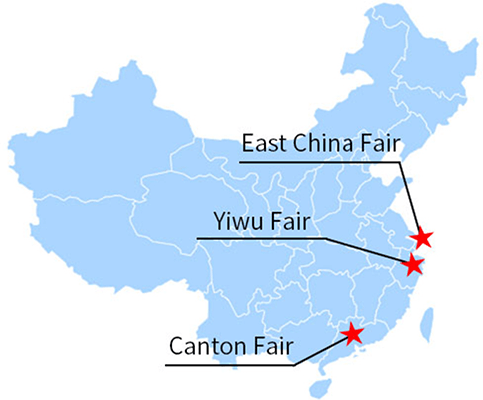
You can also buy the products from exhibitions and fairs in China. There are two types of exhibitions in China – professional exhibitions and comprehensive exhibitions.
The comprehensive exhibition is quite easy to understand, and Canton fair is one of the most famous comprehensive exhibitions in China. You’ll find many product categories at this fair.
Professional exhibitions will show products of the same category. The main advantage of professional exhibitions is that the supplier resources in one category are concentrated.
Part 3: Import Duty from China to India
What Are the Import Duties in India & How to Calculate?
All goods imported into India are subject to duties and taxes, regardless of the value. There is no minimum threshold. The structure of India’s customs tariff and fees system is complex and the generally applicable tariff is composed of Basic Customs Duty (BCD), Social Welfare Surcharge (SWS), and Integrated Goods and Services Tax (IGST).
As a basic tax, Customs collects it on all goods imported into India. The rate of duty is depending on the product category and the country of origin. It’s either a specific rate based on the unit of the item (weight, number, etc.) or a rate based on the assessable value of the item. The latter is more common, and in some cases, a combination of the two is used. You can find the latest rates of duty on customs tariff of India PDF.
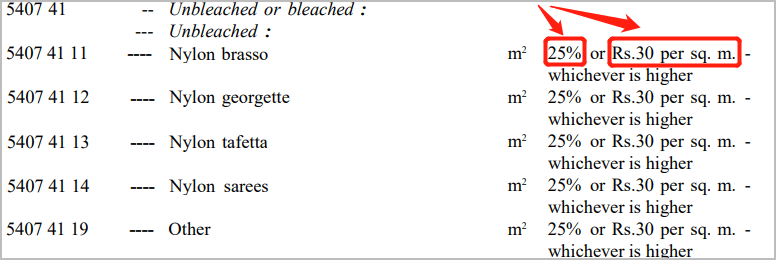
You can calculate the BCD fee by using the formula, BCD = Assessable Value * the rate of duty.
The assessable value is the CIF value. You can ask your supplier to quote you the CIF price directly or calculate it by yourself.
CIF value = Cost + Insurance + Freight
Freight value is 20% of the cost and Insurance Value equals 1.125% of the cost.
So if your goods are shipped by sea and the transaction value is Rs 10,000, we can get:
Freight Value = 20% * Rs.10,000 = Rs 2,000
Insurance Value = 1.125% * Rs 10,000 = Rs 112.5
CIF value = Rs 10,000 (Product Value) + Rs 2,000 (Freight Value) + Rs 112.5 (Insurance Value) = Rs 12,112.5 = Assessable Value
Social Welfare Surcharge (SWS)
As another duty of customs on imported goods into India, SWS was introduced in 2018 to support the government social welfare projects including education, health, and social security. This fee is levied in place of the previous Education Cesses. Goods previously exempt from Education Cesses can also be exempt from SWS.
The rate is 10% of the aggregate of duties and cesses applied and generally, that is 10% * basic customs duty.
Integrated Goods and Services Tax (IGST)
In July 2017, India implemented the Good and Services Tax (GST) system. The single GST brought together several Central and state taxes like excise duty, sales tax, value-added tax, as well as “additional duty” and the “special additional duty” that were previously levied on imports.
There are 4 different types of GST, Integrated Goods and Services Tax (IGST), State Goods and Services Tax (SGST), Central Goods and Services Tax (CGST), and Union Territory Goods and Services Tax (UTGST). But the one applying to imports and exports is IGST.
The rates of IGST are 5%, 12%, 18%, and 28%, varying from different products. IGST is levied on the value of the imported goods + any customs duties charged on the goods. Generally, IGST Payable = (Value of imported Goods + Basic Customs Duty + Social Welfare Surcharge) * rate.
Total Duty
For most goods, total duty payable = BCD + SWS + IGST
In case the assessable value (AV) of your goods is Rs 100000, the basic customs duty rate is 10%, IGST rate is 18%, and SWS is 10%
BCD = 10% * Rs 100,000 (AV) = Rs 10,000
SWS = 10% * Rs 10,000 (BCD) = Rs 1,000
IGST = 18% * (Rs 100,000(AV) + Rs 10,000 (BCD) + Rs 1,000 (SWS)) = 18% * Rs 111,000 = Rs 19,980
Total Duty = BCD + SWS + IGST = Rs 10,000 + Rs 1,000 + Rs 19,980 = Rs 30,980
In addition to the general customs duties above, sometimes your imported goods may also be levied with other related charges:
GST Compensation Cess
Compensation Cess is just applied on certain notified goods, usually the luxury and demerit category. It aims to compensate the states for any revenue loss because of GST implementation. GST Compensation Cess = (Value of imported Goods + Basic Customs Duty + Social Welfare Surcharge) * rate.
Anti-dumping Duty
This is levied on specific goods imported at a lower value than their market price to protect local industry from cheap imports. For example, India has imposed anti-dumping duty on five Chinese products for five years, including certain aluminum goods and some chemicals. The rate is also by notification.
Safeguard Duty
If the imported quantities are too much and are considered a threat to the local industry, the government may impose safeguard duty on your articles. And the rate is by notification too.
Customs Handling Fee
The Indian government assesses another 1% customs handling fee on all imports.
Considering the complexity of customs duties, it’s not so easy for importers to calculate by themselves. Are there any easier ways to estimate?
Yes, you can use Import Duty Calculators online. But the premise is that you must know the HS code of your products. And whether you can calculate the right import duties depends on the right HS code.
What is HS Code in India?
The Harmonized System is a standardized international method of classifying globally traded products. Each HS code is in six digits defined by the World Customs Organization (WCO) and represents one product category.
Countries can add more digits to the original 6-digit code to make their own HS code for further classification. That is to say, for the HS code of one product in different countries, the first 6 digits are always the same while the additional digits vary from country to country.
According to the Harmonized System, Indian customs uses 8 digits, called ITC-HS Codes, for imports and exports. It is also known as Indian Trade Clarification. ITC-HS codes are divided into two schedules. Schedule I describe the rules and guidelines related to import policies and Schedule II is related to export policies. There are 21 sections and 98 chapters in Schedule I and 97 chapters in Schedule II.
The chapters can be further divided into headings and subheadings. Take ITC-HS Codes 01041010 for example.
Chapter 01 means live animals. Heading 0104 is live sheep and goats, a more specific category under chapter 01. Sub-heading 010410 means Sheep, also a more specific subcategory under heading 0104. These six digits, 010410, are international. The last two suffix or extra digits,10, can be added by India as a further classification of sub-heading. Here, 10 means sheep including lamb for breeding purposes.
So, ITC-HS Codes 01041010 is meant for sheep including lamb for breeding purposes under sub-heading 010410 (Sheep), heading 0104 (Live sheep and goats), chapter 01 (Live Animals).
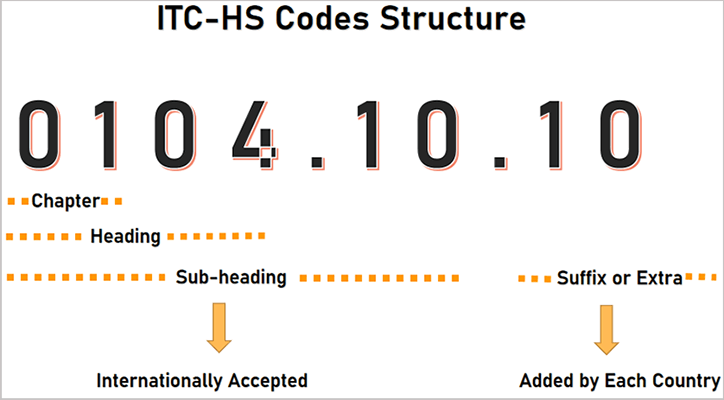
How to Search HS Code in India?
Besides going through the HS Code list on various websites like DGFT (Directorate General of Foreign Trade) or CBIC (Central Board of Indirect Taxes and Customs), you can use ITC-HS code search tools. By entering part of the ITC-HS code or a brief description of your product, you can select the most suitable ITC-HS code according to the product’s description. Here let’s see the tool on Indian Trade Portal.
Step1: Type in 2 to 6 digits of ITC-HS code or product description and then click Find.

Step2: Identify HS Code according to the product description and click “Import” to get a further classification.
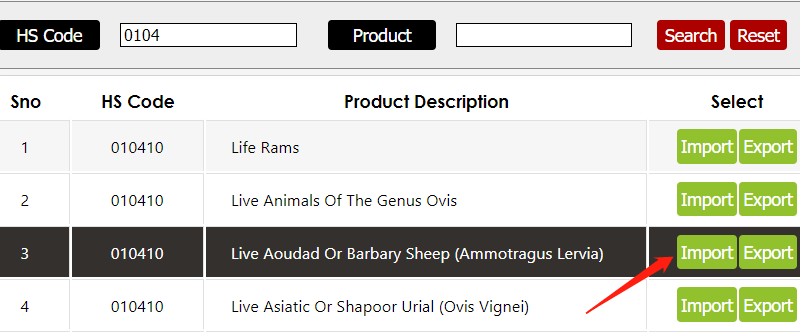
Step3: Choose a more specific HS code according to the product description.
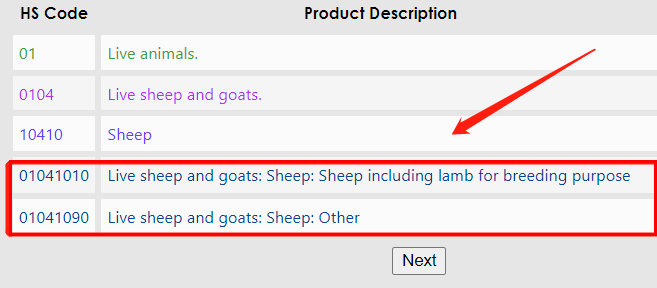
Also, if you go ahead, click “Next” and select the country of origin, you will get the tariff rate directly, as the picture shows.
How to Use an Import Duty Calculator?
Once you know your product’s HS code, you can use the Import Duty Calculator to estimate the duty payable directly. With no need to search various rates of duty and use several formulas, these calculators can save your energy and time.
Let’s see how to use the calculator on IceGate, or Indian Customs Electronic Gateway, a national portal of CBIC (Central Board of Indirect Taxes and Customs).
Step1: Enter the CTH-HS Code of your product, 2-8 digits, or product description. Take CTH-HS Code 42031010 for example.
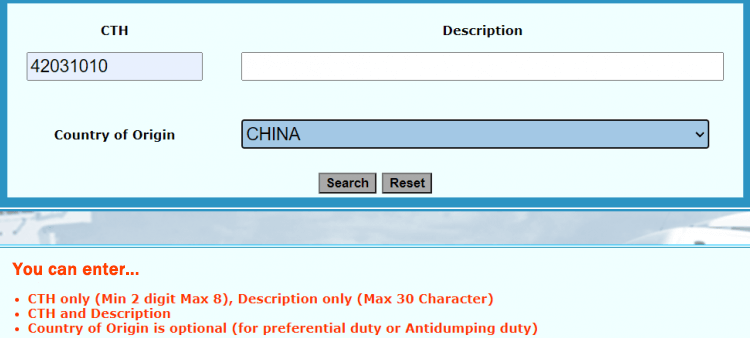
Step2: Click “search” and you will see the rate of duty, 10%, on the page. But that’s not all. You have to click the HS code “42031010” to see the detailed structure of duty and the Duty Calculator, just as shown below.

Step3: Enter your assessable value in INR (CIF value), like INR 5,000, and press “Enter”, you will get the total duty. Click “show duty bifurcation”, you will see the duty amount in detail.
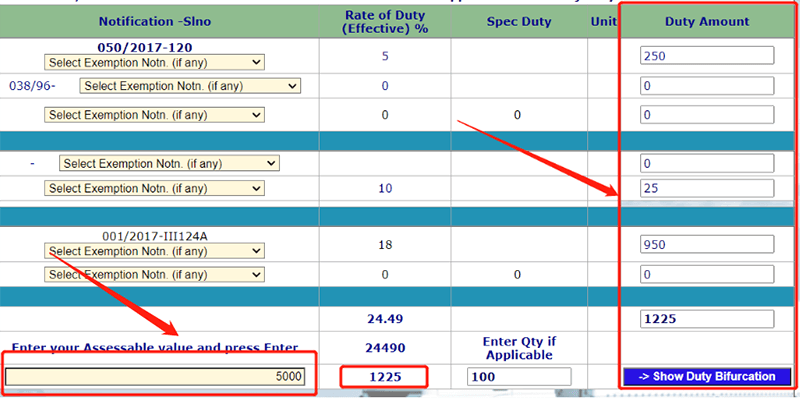
Other Calculators
Except for the calculator on IceGate, there are other calculators on some non-governmental portals such as:
You need to enter relevant information required by the tools, like HS code, product description, CIF value, country of origin, country of destination, etc., to get the estimated duty fee.
But pay attention, these are only guidance and reference. The actual duty fees are finally determined by Customs. And the tools sometimes may not reflect the recent changes. So, you’d better always check the latest notifications of Customs on the CBIC website.
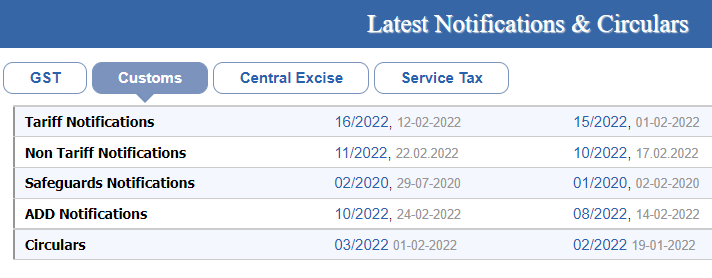
How to Pay Customs Duty in India?
IceGate is also available for paying customs duty online by following steps:
- Login in ICEGATE e-payment portal
- Enter or select the information needed by E-payment Gateway: Document type(BE, MBE, BD, SB), ICE Code & Location Code.
- Submit the above information to get the list of all your unpaid challans.
- Select the challan you want to pay for.
- Select a bank from the list and automatically redirect to the corresponding Bank Portal for payment.
- Redirect to IceGate transaction status page and get a reply: Transaction Done Successfully! Or Transaction Failure! Or Transaction Pending at Bank!
- Print transaction receipt – You can print today or the previous day’s transaction.
- For incomplete transactions, please move to the Incomplete Transaction page for verification from the bank.
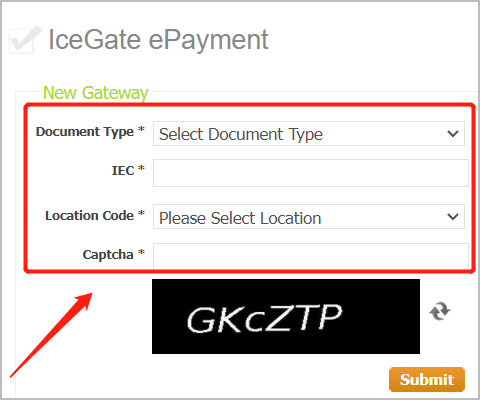
How to Avoid Customs Duty in India?
India imposes duties on any imported goods. Even gifts are not duty-free, as long as the value is over Rs 5,000. So generally, there is no way to avoid customs duties.
However, due to high tariffs, India has various preferential policies on import tariffs, like IGCR, EPCG, Project Imports Scheme, etc. For importing from China to India, the most applicable policy is IGCR (Import of goods on concessional rate of duty).
According to IGCR, certain raw materials or machinery and equipment can apply for preferential tariff import if they are imported for manufacturing and selling in India. Some may be 0 tariffs.
Not all goods can apply for IGCR, and the specific preferential duty rate should be checked according to the HS CODE. When using the calculator on IceGate, you can select Exemption Notification of each type of duty (if any).
For the latest Exemption Notifications, you can get them from the CBIC website.
Part 4: BIS Certification in India
What Is BIS?
The Bureau of Indian Standards (BIS) is a national India certification body. In 1987, BIS took the overall function of ISI (the Indian Standards Institution). As the largest certification body in India, it is responsible for various activities, such as formulating Indian quality standards, product certification, hallmarking, testing, calibration scheme, etc.
BIS has been operating a Foreign Manufacturers Certification Scheme (FMCS) since the year 2000 under BIS Act, 2016. Under FMCS, the license can be granted to a Foreign Manufacturer to use the Standard Mark on a product conforming to Indian Standards.
The Scheme is applicable for all products except electronics & IT goods notified by the Ministry of Electronics & Information Technology (MeitY). And the license is granted by Foreign Manufacturers Certification Department (FMCD) located at BIS Headquarters, New Delhi. This is BIS ISI certification.
For electronics & IT goods notified by MeitY, BIS also operates a Compulsory Registration Scheme (CRS). This is BIS CRS certification.
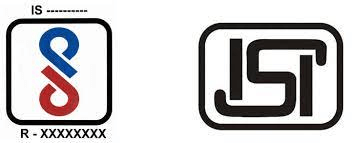
According to the regulations of the Indian government, the BIS certification is mandatory for several electrical items in India, including semiconductor motor controllers, circuit breakers, voltage switchgear, etc. You can get the BIS compulsory certification list on the BIS official website and more and more other products will be included:
Pleased Noted: BIS Registration Certificate is only issued to Manufacturers (factory owners), not to importers or traders. All Importers and Traders need to get BIS Registration for their manufacturers before their imported products under compulsory certification enter India.
How to Get BIS Certification?
Generally, there are 4 steps to get BIS-CRS and 5 steps to get BIS-ISI.
- Application (Fill-up the prescribed application form & necessary documentation)
- Factory Audit (only for BIS-ISI)
- Product testing
- Certification
- Marking
You can apply online on e-BIS. For more detailed information about the application and BIS certification cost, you can visit BIS governmental portal. There are step-by-step guides for you and you can download the application forms and checklist of documents.
Part 5: Shipping Method & Cost & Time from China to India
As far as transport is concerned, there are three prominent ways to ship from China to India:
Air Transport
Air freight can transport your goods from a factory in China to your warehouse in India within 10 days as it is a fast shipping method. For example, shipping from Shenzhen, China to Mumbai, India may take you 7 days.
So, if you are looking for a shorter delivery time, shipping the cargo via air will be your best bet. However, it’s important to note that while you’ll save plenty of time, you’ll be spending a lot more money as air freight is more expensive than sea transport.
Sea Transport
Sea transport is the cheapest way to transport your products from China to India. It involves the carriage of goods by ship and delivery at the port of discharge. The process is complicated but much more cost-effective than air freight.
While for shipping time from China to your destination port, it may be about 20 days, which is much longer than air transport. For example, shipping from Shenzhen to Mumbai by sea may take you 17 days, 10 days more than shipping by air.
Express
If you are in need of door-to-door goods deliver from China to India, then Express service is your best option, like DHL, UPS, FedEx, etc. Usually, express is for small-batch goods. For example, we always send samples to our clients by express.
The official price is generally high and the shipping costs can often fluctuate, as it can be influenced by various factors, like the impact of season, the amount of empty space left on the plane, and the difference in the agents’ discount.
For shipping time, express is the fastest way. It may take you only 4-5 days from China to India.
Labeling Requirements
As an Indian importer, you must comply with the marketing and labeling requirements. Importers who do not do so may have their cargo seized by the customs authorities. You will find below the list of items to include:
- Date of manufacture
- Product name and description
- Net weight
- Maximum retail price, including taxes
- Batch Id
- Your address
- Month & year the product was imported
- Country of origin (Made in China/PRC)
Custom Documents
The Bill of Entry (BoE) is the most important document when importing from China to India. The document specifies the type of item and its value. However, it does not always have to be completed by the importer and can be automatically generated upon arrival. However, you must prepare the following documents before the shipment arrives:
- Bill of Lading (Sea Freight) or Air Waybill (Air Freight)
- Commercial Invoice
- Packing List
- Health / Food Safety Certificate (only for food products)
- Certificate of Origin (if applying for reduced duty rate)
- Insurance Policy / Note
- Product Description / Catalog
- GATT & DGFT Declarations
- Health / Food Safety Certificate (only for food products)
- Certificate of Origin (if applying for reduced duty rate)
- Proforma Invoice
- Purchase Order or Letter of Credit
- Industrial license (if required)
Yes, the shipping process from China to India is complicated and involves a lot of paperwork. Therefore, it is really necessary to choose a professional shipping agent to help you.
Top Products Imported from China to India
Products imported from China to India are quite low in price. Many Indians still feel the products are expensive, mainly because the nature of Indian trade is a proxy pattern. It means that the goods go through a minimum of triple agents before they reach the customers.
As time’s changed now, one can easily import from China to start an online selling business. With the increasing number of internet users, India’s e-commerce market has also escalated. The e-commerce market is thriving due to the popularity of the internet.
What Products Do Indians Like to Import from China?
According to various Indian reports, electronic products take the largest piece of pie, like telephone equipment including mobiles and components. Also, India imports a higher dollar worth of Electric Lightings from China than from other countries.
India’s auto parts are another large imports from China, according to data from the Auto Component Manufacturers Association of India (ACMA).
Recently, Indian importers also like purchasing toys from China, especially injection-molded plastic toys and electronic toys. Besides, critical pharma ingredients, furniture, food, textiles, etc. are also common imports.
From 2019 to 2021, the annual import value of electrical machinery and equipment is always the highest among all commodities, followed by organic chemicals, nuclear machinery, fertilizers, optical and medical apparatus, iron and steel, etc, according to the trade statistics of the Indian Commerce Ministry, as shown below.
Also, Chinese fashion products are quite popular in India.
Facebook and BCG released a report that showed more than 30% of first-time online shoppers started purchasing clothes and shoes and 70-75% experienced online shoppers buy clothes, shoes, hats, and accessories.
Besides, Umang Bedi, general manager of Facebook in India, said in an interview with the IANS, “Fashion is one of the most favorite categories in India. Moreover, on Instagram, one out of every two Indian users is interested in fashion.”
Your Business Opportunities
As the middle class is growing, consumer demand is also changing, and hence new opportunities arise. According to research by ASSOCHAM and NEC, the Indian middle-class population is growing and will reach 110 million in the next decade. The growth in disposable income has led to a surge in consumer demand for electronic products such as advanced television, mobile phones, and computers.
A report shows that there will be a huge growth, as high as 41%, in the compound annual growth rate (CAGR) of electronic product demand in India.
Another example, the middle class has enough money, and the first thing they do is buy a new house. So, India is now in a residential adjustment period. Like, the traffic jam in New Delhi is not because of the number of cars but of the houses that are being built everywhere. Therefore, the home building materials and hardware industry in India is thriving. On top of that, it contains many business opportunities.
Also, the growth of the middle class has also spawned new living habits. For instance, most of the Indian middle-class couples (both husband and wife) are doing jobs. They don’t have time to cook at noon which took a toll on the microwave industry. These types of many examples can be found in India.
The end
This is the process of importing from China to India and the new chances for your reference, maybe you can start your import journey now.
Did you learn something new from this guide?
Or maybe you have a question.
Either way, leave a comment below or contact us to help you import goods from China.
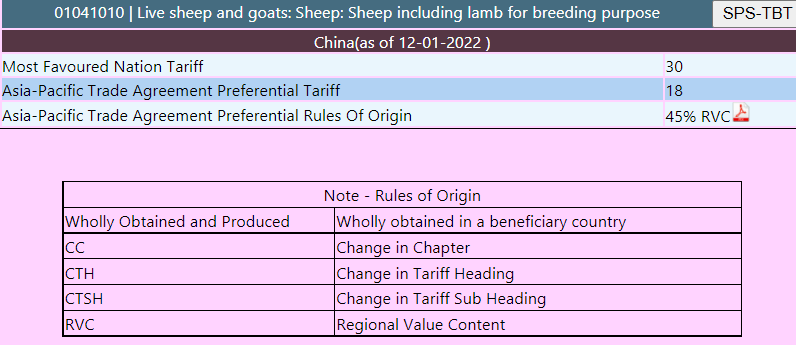
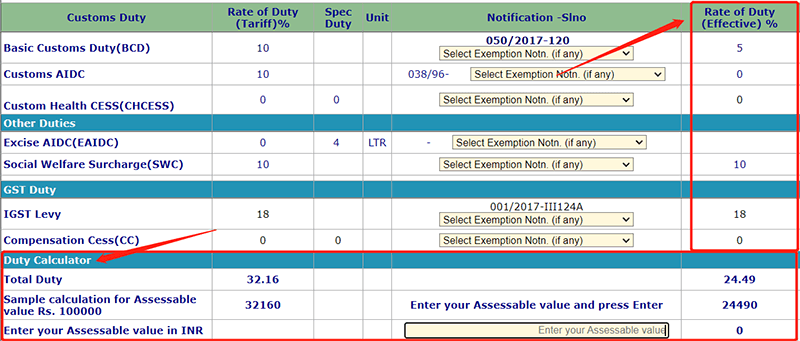
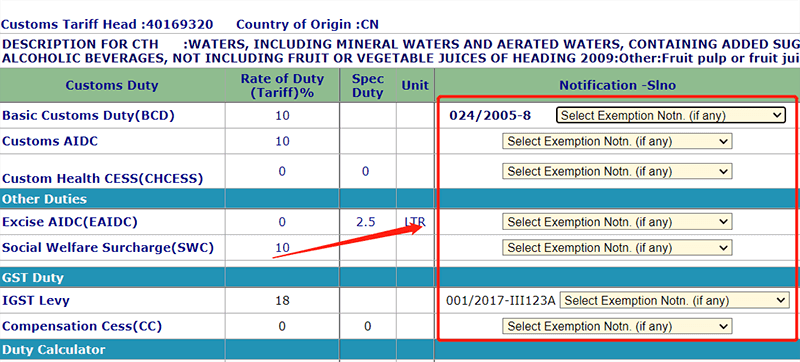
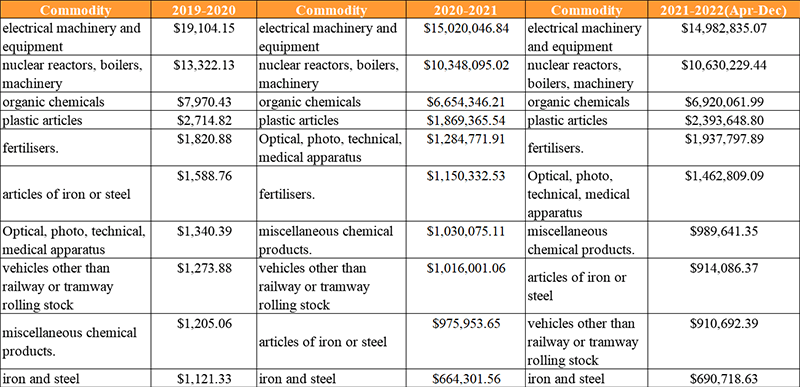

Ensuring all required documents, such as the commercial invoice and bill of lading, are accurate and complete is essential to avoid customs clearance delays when importing from China.
Excellent info thanks.
Thank you for your comment!
Wonderful Information. Keep sharing.
Its very insightful for new joiner in trade business i also updated my knowledge with this nice article. thank you
The comprehensive exhibition is quite easy to understand, and Canton fair is one of the most famous comprehensive exhibitions in China. Thanks for the information!
A very good explanation.
Really informative. Thank you for sharing this valuable information
good work
Good work, really useful, thank you.
Thank you for your comment, Sunil. We will keep going!
very good insight
Thanks for your comment!
Resourceful and well described
Got directions to dive in
thankyou and will look forward for more information
Hi, thank you for your appreciation. Your support is the best force for us.
Wonderful Information.. Keep sharing.